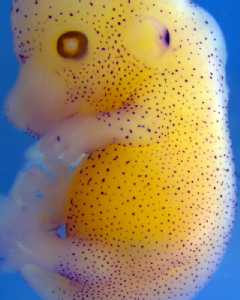- Homepage
- Research
- Research groups & Laboratories
- Mechanisms of skin development
Forschungsprojekte
Our research is focused on studying cell fate decisions during skin development because many skin diseases disrupt tissue homeostasis and recapitulate developmental programs. We use genetic approaches in the mouse to investigate the roles of signaling pathways, cell division and cytoskeletal organizers in in cell fate choices during hair follicle and epidermal development. To address our hypotheses, our lab also utilizes cutting edge techniques of gene editing such as the CRISPR/Cas9 system, transcriptomics, proteomics and organ and cell culture methods.
Around E 12-18 of skin development, the epidermis is transformed from a single-layered simple ectodermal epithelium into a complex stratified barrier before birth. We are studying the roles of cell division and migration during the early steps of epidermal stratification, which we believe are also used in hyperproliferative skin disorders such as psoriasis and atopic dermatitis.
Around the same time, the first hair follicles are formed through an interaction between the mesenchyme and overlying skin epithelium, and are precisely spaced and patterned (figure). We are dissecting the signaling hierarchies that determine hair follicle initiation and patterning, which will shed light on our understanding of hair disorders such as hypotrichosis.
Khatif, H., Bazzi, H. (2023). Generation and characterization of a Dkk4-Cre knock-in mouse line.Genesis, e23532.
Bartsch, D., Kalamkar, K., Ahuja, G., Lackmann, J.W., Hescheler, J., Weber, T., Bazzi, H., Calmer, M., Mendjan, S., Papantonis, A., Kurian, L. (2023). mRNA translational specialization by RBPMS presets the competence for cardiac commitment in hESCs. Sci Adv, 9(13), eade1792.
Damen, M., Wirtz, L., Soroka, E., Khatif, H., Kukat, C., Simons, B.D., Bazzi, H. (2021). High proliferation and delamination during skin epidermal stratification. Nat Commun, 12:3227.
Xiao C, Grzonka M, Meyer-Gerards C, Mack M, Figge R, Bazzi H. (2021). Gradual centriole maturation associates with the mitotic surveillance pathway in mouse development. EMBO Rep, 22(2), e51127
Bazzi, H.#, Soroka, E., Alcorn, H., Anderson, K.V.#. (2017). STRIP1, a core component of STRIPAK complexes, is essential for normal mesoderm migration in the mouse embryo. Proc Natl Acad Sci U S A, 19;114(51), E10928-E10936. # Co-correspondence.
Insolera, R.*, Bazzi, H.*, Shao, W., Shi, S.H., Anderson, K.V. (2014). Cortical neurogenesis in the absence of centrioles. Nat Neurosci, 17 (11), 1528-35. * Co-authorship.
Bazzi, H. and Anderson K.V. (2014). Acentriolar mitosis activates a p53-dependent apoptosis pathway in the mouse embryo. Proc Natl Acad Sci U S A, 111 (15), E1491-500.
Bazzi, H., Fantauzzo, K.A., Richardson, G.D., Jahoda, C.A. & Christiano, A.M. (2007). The Wnt inhibitor, Dickkopf 4, is induced by canonical Wnt signaling during ectodermal appendage morphogenesis. Dev Biol, 305(2), 498-507.
Bazzi, H., Fantauzzo, K.A., Richardson, G.D., Jahoda, C.A. & Christiano, A.M. (2007). Transcriptional profiling of developing mouse epidermis reveals novel patterns of coordinated gene expression. Dev Dyn, 236(4), 961-70.
Kljuic, A., Bazzi, H., Sundberg, J.P., Martinez-Mir, A., O'Shaughnessy, R., Mahoney, M.G., Levy, M., Montagutelli, X., Ahmad, W., Aita, V.M., Gordon, D., Uitto, J., Whiting, D., Ott, J., Fischer, S., Gilliam, T.C., Jahoda, C.A., Morris, R.J., Panteleyev, A.A., Nguyen, V.T. & Christiano, A.M. (2003). Desmoglein 4 in hair follicle differentiation and epidermal adhesion: evidence from inherited hypotrichosis and acquired pemphigus vulgaris. Cell, 113(2), 249-60.




